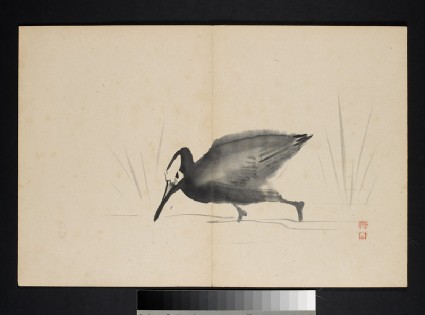Browse: 10610 objects
- Reference URL
Actions
Album of figures, plants, and animals
-
Details
- Associated place
-
Asia › Japan › Honshū › Kyōto prefecture › Kyoto (possible place of creation)Asia › Japan › Honshū › Osaka prefecture › Osaka (possible place of creation)
- Date
- late 18th century
- Artist/maker
-
Mori Tetsuzan (1775 - 1841) (artist)attributed to Mori Hakuhō (active 1800 - 1820) (artist)Mori School (active second of the 18th century - 19th century)Maruyama-Shijō School (active late 18th century - late 19th century)
- Material and technique
- ink on paper
- Dimensions
-
album 29.4 x 21.7 x 3.5 cm (height x width x depth)
page 8.9 x 43.2 cm (height x width)
leaves 30 (count)
- Material index
- Technique index
- Object type index
- No. of items
- 1
- Credit line
- Presented by M. Georges van Houten, in memory of his wife Anne Suzanne, 1961.
- Accession no.
- EA1962.209
-
Further reading
Katz, Janice, Japanese Paintings in the Ashmolean Museum, Oxford, with an introductory essay by Oliver Impey (Oxford: Ashmolean Museum, 2003), no. 28 on pp. 104 & 105, pp. 13 & 84, illus. pp. 104-107
Location
-
- currently in research collection
Objects are sometimes moved to a different location. Our object location data is usually updated on a monthly basis. Contact the Jameel Study Centre if you are planning to visit the museum to see a particular object on display, or would like to arrange an appointment to see an object in our reserve collections.
Publications online
-

Japanese Paintings in the Ashmolean Museum
Tetsuzan has used a very wet brush to render a variety of subjects including vegetables and other plants as well as flowers, animals, everyday figures and immortals. Using either blue, black or grey ink for each image, the ink has soaked into the paper to produce a variety of effects: from the feathers of a bird, the fur of a mouse to the smoother hide of an ox. In other images, the ink wash outlines the contours of a white heron or white rabbit whose colour is that of the blank paper. The reclining deer and horse, by far the most powerful images in the album, use still another technique of rendering the outlines of the animal in dark ink and the fur (or mane in the case of the horse) in a lighter wash.
The mass of the deer as it leans sideways with its foot teetering in the air is clearly felt. Also, the bulk of the horse is wonderfully conveyed through the strength of the artist’s lines. Paintings of horses in this manner have a long history in the Maruyama and Mori schools. For example, compositions by Maruyama Ōzui and Mori Shūhō were influenced by illustrated books such as Ōoka Shumboku’s (1680-1763) Soga benran [see Kobijutsu 49 (Sept. 1975) for Shūhō’s paintings of horses and for the Soga benran]. In fact, the buffalo in Tetsuzan’s album is nearly identical to one painted by Shūhō on a two-fold screen [Ibid]. The same subject is most famously taken up by Tetsuzan himself in his painting of two cattle done on silver leaf in the Tokyo National Museum [this is published in Kokka 628 (March 1943), plate 3 and page 82]. Tetsuzan had two methods of painting animal fur, one was to meticulously construct the fine texture through delicate brushwork, while the other used forceful lines in a sketchlike manner which was common in Maruyama school circles. The images in this album are in the latter style.
Tetsuzan was born in Osaka as the son of Mori Shūhō, but was adopted by his uncle Sosen, the famous painter of monkeys. After studying painting with his uncle, Tetsuzan became one of Maruyama Ōkyo’s pupils in Kyoto. In 1795 at the age of twenty-one, he joined the master and his most distinguished pupils in painting rooms at Daijōji temple. Tetsuzan became one of the premier painters of the Maruyama school, and even married into it: he and Maruyama Ōzui were married to sisters. He had a reputation for painting animals imbued with life and for realistically expressing the texture of animal’s fur with ink. A few images in this album have seals that could read ‘Hakuhō ’, perhaps indicating that the work of Mori Hakuhō is included here.
© 2013 University of Oxford - Ashmolean Museum

